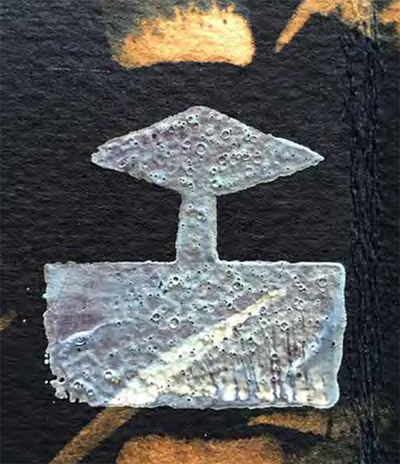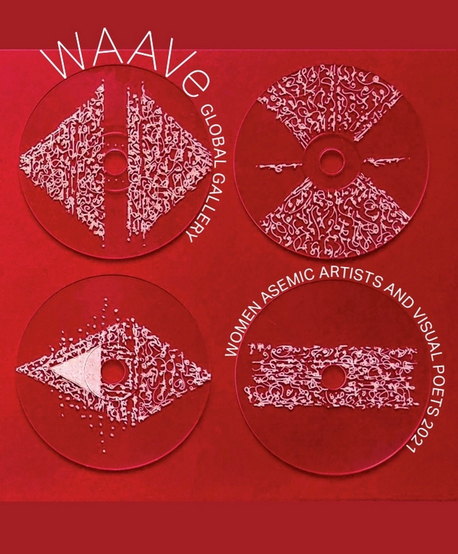WAAVe Global Gallery Women Asemic Artists and Visual Poets
March 2022
“As I begin my winding journey that is this introduction, I am reflecting not only on the salience of the work in this book: its form, diversity, voice, and aesthetic, but on the devaluation, over the ages, women and culturally diverse practitioners have experienced. The declination and renunciation pursues us with many costs to culture and art, but at personal expense as well. I won’t go to an exhaustive list of historical movements and instances that have exemplified this notion (though some of that may appear in the many writings in this book). Rather, that is for another time and place.
No, as I begin my work in this piece, for this book, I want to start with the spirit and collective found here. First of all, the movement/form/organizing principle of the book is not an exhaustive catalogue of asemic and visual poetry: think of this book as a gallery. To create such a catalogue would, in many ways, be a disservice and, also support a more hegemonic discourse of editorially linear spaces. Anyway, how can you include everyone? What is polarizing, then, is the linear and seemingly exhaustive nature of presenting art and poetry. Me, not you. The editors and I have discussed this when approaching our task here. I think there is a lot of room to continue this discourse.
This book is comprised of six sections, each with an editor who has chosen a theme or idea and several artists who represent that theme. The editors have worked tirelessly and with great respect to create their sections, that we have also referred to as galleries.Think of this as a museum filled with different galleries. I chose editors having a vision of diverse voices, theories and ideas, and backgrounds. You will see emerging artists as well as veterans, who are often highly-respected editors, practitioners, and curators. I have to say that my choices for editors were very intuitive. I think, in the back of my mind, this project was destined to be a serial one. For the first edition, I wanted to draw heavily on the Italian roots of our fields. You will see two sections dedicated to primarily Italian artists. Since my short time working in the asemic and vispo worlds, I have been in great admiration of the artists from Italy. I am sure there is plenty of research and theory about Italian art, its creative spring among other things — and that shows up here, too.
As a special addition, Cheryl Penn has written an essay exploring the history of the Bhubezi women and asemic writing. A brilliant piece.
Because this is a global project, the editors and I were decidedly intersectional in our inclusivity.
As you can see, although I am the Managing Editor of this anthology, the book is a collaboration between many women. It is non-linear, you can go from one section to another, skip around, flip through. I really see myself as the administrative assistant for this project. The women I have chosen to be editors are the stars, as are their contributors. Many of the decisions of this book were collective — from choosing a cover, to what kind and how much prose to include in the book.
This book would not exist without any of the editors: Dona Mayoora, Cinzia Farnina, Nicola Winborn, Tommasina Bianca Squadrito, and especially Terri Witek. I would like to express the utmost gratitude to Terri who is a teacher, an organizer, an amazing practitioner, and all-around good trouble-maker. Terri had wanted to do an anthology for a while. When WAAVe was created, she kept suggesting we work together. So much of this project was Te r r i. If you know Terri, you know what I mean. She is behind a lot of the success of many things and people in the asemic and vispo spaces. I am eternally grateful to her for trusting me, a newbie, with the work of all of the contributors.
When I came to the land of asemia a couple of years ago, I noticed a lack of inclusion of diverse groups and women in publications, yet I saw so much work being produced. So much innovation. I think WAAVe Global was part of my answer to working on that. Lately, I have seen a little more inclusion, but there is still work to do. I am not going to end on that cliché though. We are not living for the future, for what could come — we are working in the present from the past with each other and we demand your attention now. If I can assist you in any way in doing that, here is my submission.
Imagine you are in a gallery, walking around, enjoying a drink, spectacular art, and the company of others.”
— Kristine Snodgrass
“This is without doubt an important book. There is so much there! I will study this book. I hope you will continue to publish similar books, or maybe make this a periodical of sorts, publish it once a year. I am no better at predicting the future than anyone else, but I feel certain that the international community of asemic writers will increasingly serve as a powerful area for explorations and expressions by and about women. There are already threads of radical feminism in the expanded history of asemic writing and its ancestors. I haven’t attempted any kind of scientific evaluation of this, but it seems to me already that much of the best work currently being produced and circulated under the umbrella of asemic writing is being done by women. If we can identify that currently as a trend, then we can probably also identify it as a characteristic of the practice. Maybe when the dust settles on all of this it will turn out that the asemic movement was yet another front in the ongoing struggle for liberation in all of its myriad variations.”
— Jim Leftwich
BHUBEZI WOMEN WRITING SYSTEM
an excerpt from Cheryl Penn’s essay
“History is a strange animal – it’s elastic.
REAL history? Now that’s another creature all together, and part of that history involves asemic writing. Its antiquity is often attributed to Master of the Cup Zhang Xu, perhaps Man Ray and various others. But this is not so.
Let me try begin at the beginning. Take it or leave it, this story is lost in the clouds, known only to a select few and is definitely only for the Instructed. There’s a world we don’t know called In-Between.
It’s a place of bridges and shadow lands, Curious B’s, strained semantics and Women who through time have altered the course of history. They’re REAL women, known to most, but understood by few. They’re called the Bhubezi Women: The Women Who Hold Up the World.
Among their numbers are Hatshepsut (the fifth pharaoh of the Eighteenth Dynasty of Egypt), Empress Zhangsun (born 15 March 601AD), Pandora (completely misunderstood by ancient Greek philosophers), Mona Lisa (actually Leonardo da Vinci’s mother, Catherine), Cynisca (a Spartan princess born about 440BC) and Hypatia (a Hellenistic astronomer, philosopher and mathematician who came from Alexandria).
Their guardians are the ancient Lamassu (which the Babylonians unfortunately deified), and much of their written communication regards the fabric of the world between their work at the Bridges In-Between and our world.
Their scribe bears the name Lyrehc, and their script is the original asemic writing, but it was never called this. A translation is impossible, but the glyph below speaks of the concept of writing and all its meanings – communication, emotion, instruction, intellect, action and beauty.”
 BABYLONIAN GLYPH THAT SPEAKS TO THE CONCEPT OF WRITING
BABYLONIAN GLYPH THAT SPEAKS TO THE CONCEPT OF WRITING
For more information and to order a copy of WAAVe Global Gallery →

